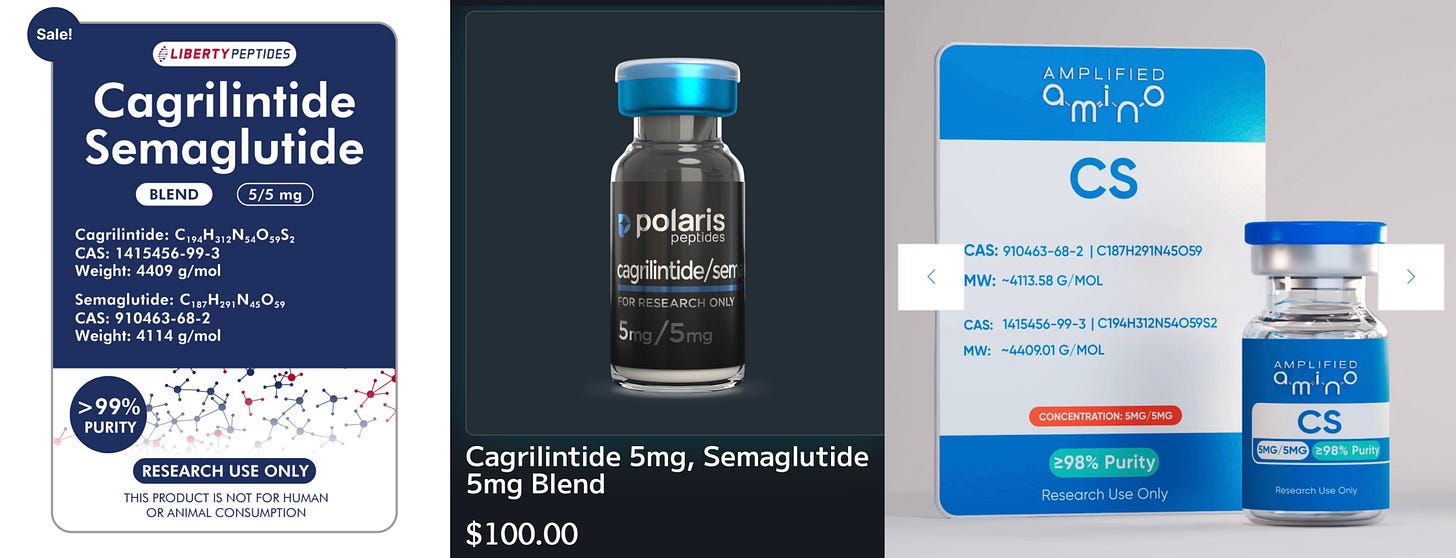Most of the time I try not to be alarmist.
But every now and then something comes along that demands it. This is one of those times.
Lately I’ve been hearing from people experimenting with research grade cagrilintide. They’re mixing it with bacteriostatic water and injecting it like it’s no big deal. Some are stacking it with GLP-1 meds to mimic Novo Nordisk’s CagriSema. Others are just curious. Hoping for a stronger hit of amylin to quiet food noise or curb appetite.
I get it. I really do. But this isn’t just another off label peptide.
This one is potentially dangerous. And it’s dangerous in a way that most people do not understand.
I want to try to break that down for you, but in doing so, I want people to understand that I am also deeply compassionate, and fiery passionate about the conditions that have pushed so many in the grey market obesity treatments in the first place. I say all this as a person who has spent countless hours, and thousands of my own hard earned dollars to fight for affordable access.
I am not calloused or cold towards the people who choose these options. I am, however, weary of people who take advantage of an already marginalized group of people for their own gain, without informing us of the potential risks.
Amylin is different
Cagrilintide is an amylin analog. And amylin has a nasty habit of turning into something called amyloid fibrils. These are long sticky strands of misfolded protein. Once they form you can’t undo them. And they’re not just inactive. They’re toxic.
Amyloid fibrils have been linked to type 2 diabetes. To Alzheimer’s. To systemic organ damage. You do not want to be injecting anything that even has the chance of forming them.
That’s exactly what could potentially happen when you mix research grade cagrilintide with water and inject it. Especially without a stabilizer. Especially after it’s been sitting around in your fridge for a few days.
What can go wrong
Fibril formation doesn’t just make the peptide stop working. It can cause real harm. Here’s what you’re gambling with:
Tissue damage at the injection site
These fibrils can trigger inflammation and cell death. You might think the dose is weak. But what’s actually happening is cellular toxicity under the surface.
Unpredictable dosing
Once a molecule misfolds it can’t do its job. That means part of your dose might work. Part of it might not. The result is a rollercoaster of effects that make no pharmacological sense.
Long term risk
If even a small amount of these fibrils makes it into circulation there is the potential for organ deposition over time. We do not have long term data on what that means for patients who are injecting unstable amylin. But the warning signs are there.
Novo Nordisk separates them for a reason
People assume that if semaglutide and cagrilintide are safe together in a Novo drug, then they must be safe together at home. But what they miss is that Novo delivers them using a dual chamber system.
That’s because each compound requires a completely different environment to remain stable. Different pH. Different solvents. Different handling.
They’re not just tossing it all in a bottle and hoping it holds.
If bac water was enough to protect the compound, Novo would have done that years ago.
But they didn’t. Because they know what’s at stake. Yet research grade companies are selling the semaglutide/cagrilintide mixutre all over the internet.
Yes, Novo is testing a single chamber version, but that’s exactly the point
Now to be fair, Novo Nordisk just launched a Phase 1 trial of a true combo CagriSema, where both semaglutide and cagrilintide are delivered in a single chamber. We covered this back when it was first announced if you’d like to learn more.
That is not evidence this is safe to replicate at home. It’s proof that it isn’t.
Because if it were easy, they would’ve done it from day one. Instead, they’ve spent years working with dual chamber delivery to keep the drugs apart. This new single chamber formulation is being treated like a massive breakthrough. Because it is. It’s a scientific hurdle they’re only now trying to clear—and they’re doing it with top researchers, tightly controlled variables, and a clinical trial protocol.
It is unproven. It is experimental. And they are taking it seriously for a reason.
So if you think research grade cagrilintide mixed with bacteriostatic water can get you the same outcome, ask yourself why Novo hasn’t already done that. Ask yourself why the Phase 1 trial is necessary.
Because this is not just powder and water. This is chemistry. This is biology. This is risk.
I’m not saying this to scare people. I’m saying it because nobody else is.
The potential risks with research grade cagrilintide are not theoretical. They are known. And they are different than the risks with GLP-1s or compounded tirzepatide.
Amylin agonists are a category that should only be handled by professionals using pharmaceutical grade materials under extremely strict conditions. Not peptides in ziplocks off a Telegram channel.
If this kind of information matters to you, if it makes a difference, please consider becoming a paid subscriber.
On The Pen is built by patients, for patients.
If we’ve helped you understand your options better, help us keep doing it.
And if you’ve ever tried one of these peptides yourself, I’d love to hear your experience. Leave a comment. Send a message. Let’s document what’s really happening.















Share this post